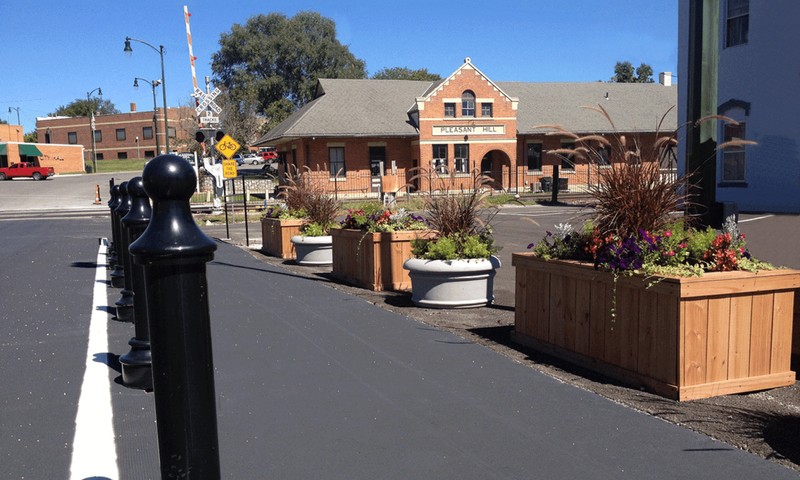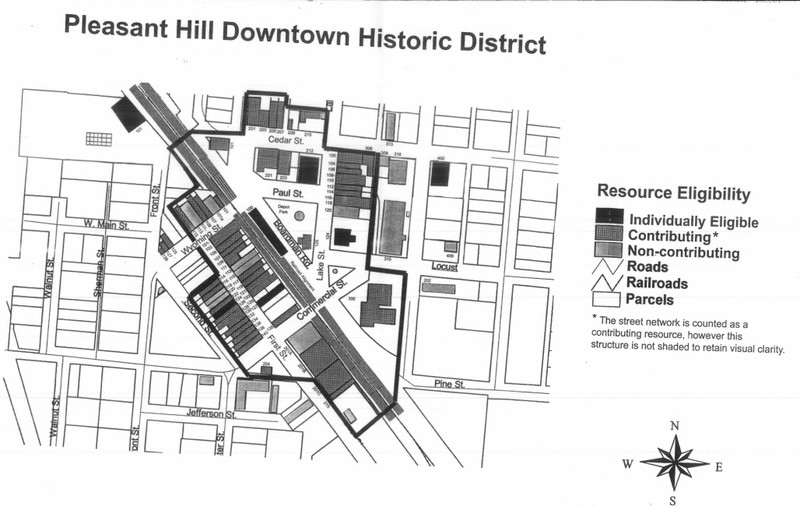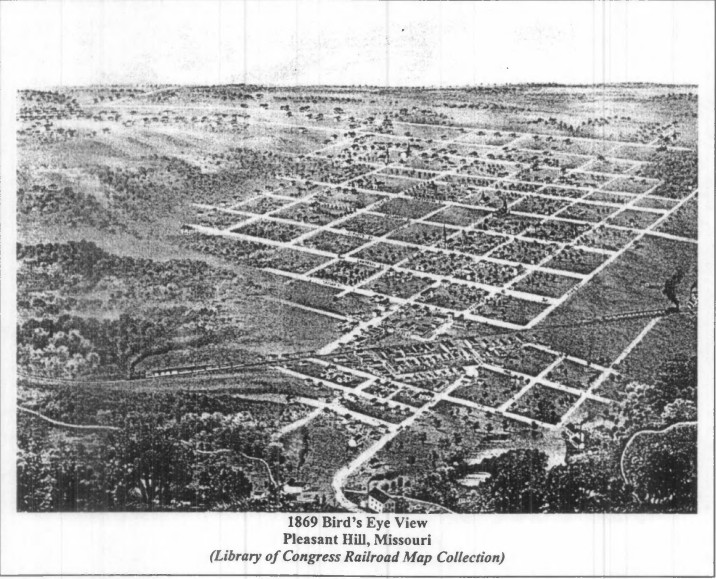Pleasant Hill Depot
Introduction
Text-to-speech Audio
Constructed for the Missouri Pacific rail line in 1903, this historic depot serves as one of the anchors of the modern-day Pleasant Hill Downtown Historic District. The historic district comprises a collection of fifty-three buildings representing approximately a century of development in downtown Pleasant Hill from the mid-nineteenth century through the mid-twentieth century. The historic district documents critical events in the town's history, including the arrival of the railroad in 1865, which effectively relocated Pleasant Hill's original location. The district and its buildings serve as physical reminders of the community's history including devastating fires and construction booms that both shaped the physical development of the community.
Images
The depot is one of the anchors of the Pleasant Hill Historic District

2004 map of the Pleasant Hill Downtown Historic District

1869 aerial view of the Pleasant Hill Downtown Historic District

Backstory and Context
Text-to-speech Audio
The first permanent settler of present-day Cass County, David Creek, arrived from Indiana in 1828 and established a homestead near what is now Pleasant Hill. Many of Cass County's first settlers arrived during the early 1830s. The establishment of a mill on Big Creek in 1832 drew additional settlers, which served as the genesis of what became Pleasant Hill in 1844 (formally incorporated in 1859).
A profound increase in railroad development occurred in the years leading up to the Civil War. Economic livelihoods grew affixed to proximity and access to rail lines. Railroad companies seized on the necessity of rail lines by choosing to run lines through towns that pledged the highest bid. Pleasant Hill's financial offer, along with its growth and potential as a commercial hub, proved enough to attract railroad planners. Pacific Railroad Company purchased dozens of acres of land near Pleasant Hill in 1858 (although most of the construction of the railway had to wait until after the Civil War).
The rural settlements of Cass County, bordering on Kansas, found themselves in the midst of a tumultuous debate regarding slavery. The Kansas-Nebraska Act allowed the nearby Kansas Territory residents to vote on the issue of slavery in their future state. As hostilities escalated in the two years prior to the start of the Civil War, a general exodus from the region began. During the war, Union troops occupied Pleasant Hill, and the surrounding area evolved into a battlefield as pro-slavery Bushwhackers raided and burned federally occupied buildings. In 1863, Union forces issued "General Order Number Eleven," which established martial law in the four Missouri counties bordering the Kansas territory, including Cass County. The order directed residents to leave their homes and move to Union Army outposts. Federal and Kansas volunteer troops then seized livestock and burned both farms and businesses throughout the border area in an effort to limit access to goods. By the war's end, almost all of Pleasant Hill sat in ruins.
The first train finally arrived in 1865, and within two years, in 1867, the city experienced a building boom, and its population quadrupled to pre-Civil War levels. "New Town" rapidly matured into the city's commercial and civic heart. The railway effectively moved the business center of town to the southwest, with lots going on sale (for large sums of money) after the Civil War near the railroad line. Indeed, new city plats extended roughly sixty blocks in each direction from the Pacific Railroad additions. Because the railroad cut through the town on a diagonal, the layout of some city street networks differs from others, which mirrors most Midwestern north-south grids; the historic district reflects this nuanced road system.
By the turn of the twentieth century, Mt. Pleasant evolved into a small-town railroad hub with added lines and branches going into town. Mt. Pleasant served as a significant shipping point for the surrounding agricultural region, and numerous industrial businesses and commercial enterprises lined the blocks adjacent to the railroad tracks. However, while the town enjoyed growth and a consistent building boom, numerous fires continued to wreak havoc on the business center. Three fires in 1888, 1891, and 1893 proved exceptionally destructive. Until 1893, Mt. Pleasant did not have a city water system or fire department, but the fire of that year inspired the city to establish a formal fire department, and they constructed a building that filled in one of the gaps created by the blaze.
Even into the 1930s, Pleasant Hill continued to thrive as a commercial town with busy railroad traffic. However, by then, the automobile had supplanted trains as the primary mode of transportation for passengers, and freight moved via trucks as much as trains. The shift to automobiles altered the city's commercial center epicenter, moving it eastward.
The Great Depression and "Dust Bowl" drought profoundly affected Cass County residents. Many regional farmers lost their farms, and a number of Cass County banks folded, although the city's banks continued to be solvent and the local economy remained relatively steady. Federal relief programs also helped the local economy remain strong. Through these programs, local governments received funding for the construction of public buildings and infrastructure, both of which provided jobs and stimulated the economy. Still, construction generally stalled during the 1930s and into the 1940s (because of World War II).
By the end of World War II, An immense wave of new construction significantly altered the appearance of downtown Pleasant Hill, particularly on the east side of the railroad tracks. After a nearly twenty-year building hiatus, the Pleasant Hill Chamber of Commerce sponsored and promoted what became known as the "Big Build," intended to be Pleasant Hill's most concerted effort for town beautification, with investments reaching $1 million. Indeed, more construction transpired during the Big Build (roughly 1945 - 1959) than in any period since its 1860s post-war rebuild. The plan commenced in 1948 with the demolition of late nineteenth- and early twentieth-century buildings, the widening of Paul Street, and the construction of the Memorial Building.
All told, the Pleasant Hill Downtown Historic District serves as a window into the history of the town's commercial district from the time the railroad arrived before the Civil War to the mid-twentieth century. A few notable buildings include:
- Knorpp's Opera House (c. 1880)
- Missouri Pacific Depot (c. 1903).
- Tucker Inn (c. 1911).
- Benson Brothers Lumber Company (c. 1925).
- Pleasant Hill Post Office (c. 1938).
- Municipal Power Plant (c. 1939).
- Booth Public Library (c. 1948).
- Memorial Building (c. 1948).
- Pleasant Hill City Hall (c. 1959).
Sources
Davis, Kerry. "Registration Form: Pleasant Hill Downtown Historic District." National Register of Historic Places. mostateparks.com. 2004. https://mostateparks.com/sites/mostateparks/files/Pleasant%20Hill%20Downtown%20HD.pdf.
Fischer, William. "Pleasant Hill, Missouri." The Historical Marker Database. 2016. https://www.hmdb.org/m.asp?m=88330.
"Our History." Pleasant Hill City Website. Accessed February 11, 2023. https://www.pleasanthill.com/pview.aspx?id=20494&catid=0.
https://www.pleasanthillhistoricdistrict.org/
https://mostateparks.com/sites/mostateparks/files/Pleasant%20Hill%20Downtown%20HD.pdf
https://mostateparks.com/sites/mostateparks/files/Pleasant%20Hill%20Downtown%20HD.pdf
